I'm doing a fairly complex NHibernate transaction in a financial system, creating a payment, recording the ledger entries, checking to see if the payment is the total amount of an invoice, if so marking the invoice as paid in full, etc... lots of fun stuff. Naturally it has to happen inside a single transaction.
When I try to commit the change to the session, I get the following error:
Error dehydrating property value for C3.DataModel.CFAPTransaction.Vendor
Googling this did not turn up many record. Can someone tell me what this means and where I need to focus my debugging efforts?
UPDATE
Per request, here is the full error message:
NHibernate.PropertyValueException: Error dehydrating property v alue for C3.DataModel.CFAPTransaction.Vendor --->NHibernate.HibernateException: Unable to resolve property: APVendorId at NHibernate.Tuple.Entity.EntityMetamodel.GetPropertyIndex(String propertyName) at NHibernate.Tuple.Entity.AbstractEntityTuplizer.GetPropertyValue(Object entity, String propertyPath) at NHibernate.Persister.Entity.AbstractEntityPersister.GetPropertyValue(Object obj, String propertyName, EntityMode entityMode) at NHibernate.Type.EntityType.GetIdentifier(Object value, ISessionImplementor session) at NHibernate.Type.ManyToOneType.NullSafeSet(IDbCommand st, Object value, Int32 index, Boolean[] settable, ISessionImplementor session) at NHibernate.Persister.Entity.AbstractEntityPersister.Dehydrate(Object id, Object[] fields, Object rowId, Boolean[] includeProperty, Boolean[][] includeColumns, Int32 table, IDbCommand statement, ISessionImplementor session, Int32 index) --- End of inner exception stack trace --- at NHibernate.Persister.Entity.AbstractEntityPersister.Dehydrate(Object id, Object[] fields, Object rowId, Boolean[] includeProperty, Boolean[][] includeColumns, Int32 table, IDbCommand statement, ISessionImplementor session, Int32 index) at NHibernate.Persister.Entity.AbstractEntityPersister.Insert(Object id, Object[] fields, Boolean[] notNull, Int32 j, SqlCommandInfo sql, Object obj, ISessionImplementor session) at NHibernate.Persister.Entity.AbstractEntityPersister.Insert(Object id, Object[] fields, Object obj, ISessionImplementor session) at NHibernate.Action.EntityInsertAction.Execute() at NHibernate.Engine.ActionQueue.Execute(IExecutable executable) at NHibernate.Engine.ActionQueue.ExecuteActions(IList list) at NHibernate.Engine.ActionQueue.ExecuteActions() at NHibernate.Event.Default.AbstractFlushingEventListener.PerformExecutions(IEventSource session) at NHibernate.Event.Default.DefaultFlushEventListener.OnFlush(FlushEvent event) at NHibernate.Impl.SessionImpl.Flush() at NHibernate.Transaction.AdoTransaction.Commit() at C3.DataModel.Repositories.NHUnitOfWork.Save() in C:\projects\C3\C3.DataModel.Generated\Generated\NHibernateRepositories.generated.cs:line 2659 at C3.WebUI.Areas.Finance.Controllers.AccountsPayableController.CreatePayment(CreatePaymentModel model) in C:\projects\C3\C3.WebUI\Areas\Finance\Controllers\AccountsPayableController.cs:line 434
UPDATE Throwing NHibernate into DEBUG mode, I get a bunch of stuff like this:
processing cascade NHibernate.Engine.CascadingAction+SaveUpdateCascadingAction for: C3.DataModel.APVendor cascade NHibernate.Engine.CascadingAction+SaveUpdateCascadingAction for collection: C3.DataModel.APVendor.Transactions done cascade NHibernate.Engine.CascadingAction+SaveUpdateCascadingAction for collection: C3.DataModel.APVendor.Transactions done processing cascade NHibernate.Engine.CascadingAction+SaveUpdateCascadingAction for: C3.DataModel.APVendor NHibernate.Event.Default.AbstractFlushingEventListener ERROR Could not synchronize database state with session NHibernate.PropertyValueException: Error dehydrating property value for C3.DataModel.CFAPTransaction.Vendor ---> NHibernate.HibernateException: Unable to resolve property: APVendorId at NHibernate.Tuple.Entity.EntityMetamodel.GetPropertyIndex(String propertyName) at NHibernate.Tuple.Entity.AbstractEntityTuplizer.GetPropertyValue(Object entity, String propertyPath) at NHibernate.Persister.Entity.AbstractEntityPersister.GetPropertyValue(Object obj, String propertyName, EntityMode entityMode) at NHibernate.Type.EntityType.GetIdentifier(Object value, ISessionImplementor session) at NHibernate.Type.ManyToOneType.NullSafeSet(IDbCommand st, Object value, Int32 index, Boolean[] settable, ISessionImplementor session) at NHibernate.Persister.Entity.AbstractEntityPersister.Dehydrate(Object id, Object[] fields, Object rowId, Boolean[] includeProperty, Boolean[][] includeColumns, Int32 table, IDbCommand statement, ISessionImplementor session, Int32 index) --- End of inner exception stack trace --- at NHibernate.Persister.Entity.AbstractEntityPersister.Dehydrate(Object id, Object[] fields, Object rowId, Boolean[] includeProperty, Boolean[][] includeColumns, Int32 table, IDbCommand statement, ISessionImplementor session, Int32 index) at NHibernate.Persister.Entity.AbstractEntityPersister.Insert(Object id, Object[] fields, Boolean[] notNull, Int32 j, SqlCommandInfo sql, Object obj, ISessionImplementor session) at NHibernate.Persister.Entity.AbstractEntityPersister.Insert(Object id, Object[] fields, Object obj, ISessionImplementor session) at NHibernate.Action.EntityInsertAction.Execute() at NHibernate.Engine.ActionQueue.Execute(IExecutable executable) at NHibernate.Engine.ActionQueue.ExecuteActions(IList list) at NHibernate.Engine.ActionQueue.ExecuteActions() at NHibernate.Event.Default.AbstractFlushingEventListener.PerformExecutions(IEventSource session) C3.WebUI.Areas.Finance.Controllers.AccountsPayableController ERROR C3.WebUI.Areas.Finance.Controllers.AccountsPayableController: No additional information. NHibernate.PropertyValueException: Error dehydrating property value for C3.DataModel.CFAPTransaction.Vendor ---> NHibernate.HibernateException: Unable to resolve property: APVendorId at NHibernate.Tuple.Entity.EntityMetamodel.GetPropertyIndex(String propertyName) at NHibernate.Tuple.Entity.AbstractEntityTuplizer.GetPropertyValue(Object entity, String propertyPath) at NHibernate.Persister.Entity.AbstractEntityPersister.GetPropertyValue(Object obj, String propertyName, EntityMode entityMode) at NHibernate.Type.EntityType.GetIdentifier(Object value, ISessionImplementor session) at NHibernate.Type.ManyToOneType.NullSafeSet(IDbCommand st, Object value, Int32 index, Boolean[] settable, ISessionImplementor session) at NHibernate.Persister.Entity.AbstractEntityPersister.Dehydrate(Object id, Object[] fields, Object rowId, Boolean[] includeProperty, Boolean[][] includeColumns, Int32 table, IDbCommand statement, ISessionImplementor session, Int32 index) --- End of inner exception stack trace --- at NHibernate.Persister.Entity.AbstractEntityPersister.Dehydrate(Object id, Object[] fields, Object rowId, Boolean[] includeProperty, Boolean[][] includeColumns, Int32 table, IDbCommand statement, ISessionImplementor session, Int32 index) at NHibernate.Persister.Entity.AbstractEntityPersister.Insert(Object id, Object[] fields, Boolean[] notNull, Int32 j, SqlCommandInfo sql, Object obj, ISessionImplementor session) at NHibernate.Persister.Entity.AbstractEntityPersister.Insert(Object id, Object[] fields, Object obj, ISessionImplementor session) at NHibernate.Action.EntityInsertAction.Execute() at NHibernate.Engine.ActionQueue.Execute(IExecutable executable) at NHibernate.Engine.ActionQueue.ExecuteActions(IList list) at NHibernate.Engine.ActionQueue.ExecuteActions() at NHibernate.Event.Default.AbstractFlushingEventListener.PerformExecutions(IEventSource session) at NHibernate.Event.Default.DefaultFlushEventListener.OnFlush(FlushEvent event) at NHibernate.Impl.SessionImpl.Flush() at NHibernate.Transaction.AdoTransaction.Commit() at C3.DataModel.Repositories.NHUnitOfWork.Save() in C:\projects\C3\C3.DataModel.Generated\Generated\NHibernateRepositories.generated.cs:line 2659 at C3.WebUI.Areas.Finance.Controllers.AccountsPayableController.CreatePayment(CreatePaymentModel model) in C:\projects\C3\C3.WebUI\Areas\Finance\Controllers\AccountsPayableController.cs:line 434
It does not appear this is occurring when querying the database. I have a feeling it has problems with me creating a bunch of objects, relating them, and then trying to persist them, but that's a pure guess.

